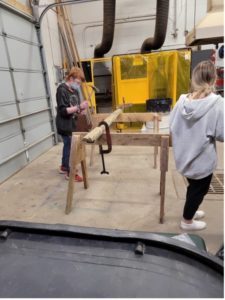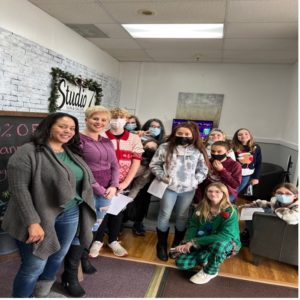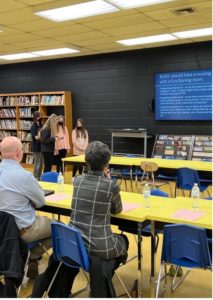On February 16, 2022, I sat down with Kayce Wooten to debrief and reflect on her role in the Our School of the Future project, described by student Olivia Blonn in our last blog. Kayce Wooten is an embedded career teacher in the 7th grade team at Buckhannon-Upshur Middle School. This position is being piloted by Kayce at B-UMS to study how student and teacher empowerment is affected when there is a teacher whose role is to embed the concepts of career exploration, the West Virginia Student Success standards, and the Empowerment Skills and Protocols into projects, experiences, and classes. Upshur County was willing to test this position to see if it is a viable option for all levels of the middle school, as well as whether it might be a position we should recommend to other schools participating in the Empowerment Academy District (EAD) model. This is a reflection of Upshur County’s willingness to engage with EAD Protocol 12, “Leadership prioritizes resources and aligns policies and procedures to support EAD protocols”.
Buckhannon-Upshur Middle School’s seventh grade students took on a project to study potential career pathways and propose classrooms for the pathways students would like to see in a proposed new high school. Kayce worked closely with the teaching team to tie the threads of this project together. Kayce describes,
“This was the first large project-based learning experience for the seventh graders, and it was completed during the time when the community was trying to lobby and vote on whether or not to build a new high school and re-imagine the middle school. If that possibility became a reality, then the 7th grade students would spend some of their high school years in the new building.”
 For the project launch, the seventh graders toured the county high school to explore what is currently offered and then attended a career fair. Students completed a survey of their current career interests and were grouped in large cohorts and smaller working teams based on their responses to the survey. This allowed teachers to focus the cohort they facilitated based on their interests in fields like design, healthcare, architecture, etc. In order to discover more about their chosen industry, students took field trips to local businesses within walking distance of the school. They asked questions of professionals, gathered information, and some had hands-on experiences. Kayce felt that these walking tour experiences were a highlight for the students. Many, such as those who are interested in the teaching profession and visited a local daycare, wish to return and continue their exploration of the career through shadowing or volunteering.
For the project launch, the seventh graders toured the county high school to explore what is currently offered and then attended a career fair. Students completed a survey of their current career interests and were grouped in large cohorts and smaller working teams based on their responses to the survey. This allowed teachers to focus the cohort they facilitated based on their interests in fields like design, healthcare, architecture, etc. In order to discover more about their chosen industry, students took field trips to local businesses within walking distance of the school. They asked questions of professionals, gathered information, and some had hands-on experiences. Kayce felt that these walking tour experiences were a highlight for the students. Many, such as those who are interested in the teaching profession and visited a local daycare, wish to return and continue their exploration of the career through shadowing or volunteering.
 Kayce describes the teaching and learning students experienced through this project: “Each content area played a part in this project. Students created an argumentative PowerPoint to defend what groups want or need in a classroom based on their career interest. Each group proposed ways their classroom would be sustainable and created digital and paper blueprints showing the layout, a budget detailing necessities, and a one-point perspective drawing of the room they would like to see in their school. Together, this created a pitch for their final product. The students presented these pitches to the team of architects from Charleston who had been designing the new school and giving voters information. The students also hosted a parent and community night to share all of their designs publicly.
Kayce describes the teaching and learning students experienced through this project: “Each content area played a part in this project. Students created an argumentative PowerPoint to defend what groups want or need in a classroom based on their career interest. Each group proposed ways their classroom would be sustainable and created digital and paper blueprints showing the layout, a budget detailing necessities, and a one-point perspective drawing of the room they would like to see in their school. Together, this created a pitch for their final product. The students presented these pitches to the team of architects from Charleston who had been designing the new school and giving voters information. The students also hosted a parent and community night to share all of their designs publicly.
In her role as an embedded career teacher, Kayce is uniquely able to work with students and teachers to expose students to a variety of career options, explore interests, and deepen student interests. In partnership with the teaching team, she helps students set and pursue goals, understand their strengths, and develop skills that will help them prepare and be successful in a workplace. During the project work, Kayce connected professionals to the project as mentors, experts, and panelists. She helped students learn to use workplace tools such as contracts, norms, collaborative documents, and communication skills to problem solve, manage conflicts, and reflect on their work. She can see a marked improvement in students’ ability to work together and hold each other genuinely accountable. In addition to the students, Kayce is very proud of the work the team of 7th grade teachers has accomplished, describing the teachers as truly functioning as a team with the students at its heart. Instructional coach Michael Lane commented, 
“It is a full collaboration based on the kids. Everybody is together, pulling in the same direction. The structures Kayce is able to provide just help everybody move as a team”.
As all of our Empowerment Academy schools and districts seek to define and demonstrate what school could look like if we truly empower students and teachers to own their learning, this is one example of a district’s willingness to invest in cultures and structures that empower students. As Ms. Wooten describes,
“These young teens proved that they want their voices to be heard and that they are craving more hands-on, authentic, and work-related experiences while they are at school. Gone are the days when children decide what they want to do when they grow up- after they graduate. This generation is getting prepared for the world of work by obtaining skills through authentic learning, entrepreneurial mindsets, and workplace environments now.”
EAD Protocols Highlighted:
EAD Protocol 1: Teachers support collaborative learning teams with authentic roles and responsibilities modeled on the world of work.
EAD Protocol 5: Teachers and students collaborate with school and community members to implement place-based, student-driven projects.
EAD Protocol 7: Local employers engage in the education of students to enhance students’ understanding of jobs and careers and the knowledge and skills they will need to be successful.
EAD Protocol 8: Teachers guide students in career exploration and planning to frame and expand upon experiences provided by local employers.
EAD Protocol 12: Leadership prioritizes resources and aligns policies and procedures to support EAD protocols.